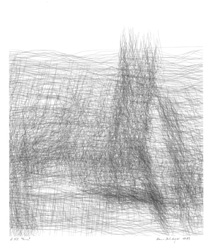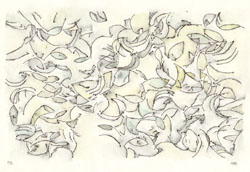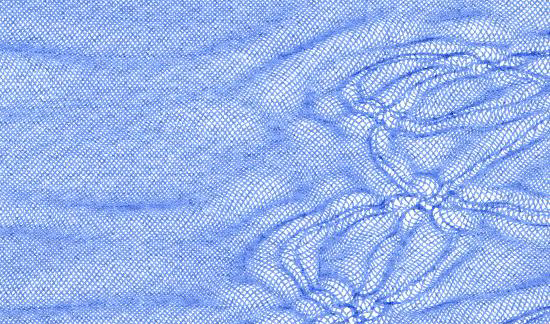Main Menu | Site Map | Search | Contact
ALGORITHMS AND THE ARTIST
Roman Verostko
1994, ISEA & 1995 SIGGRAPH
Historical notes:
1994, ISEA, Helsinki: This essay was developed as a position paper for a panel on Algorithms and the Artist at the Fourth International Symposium on Electronic Art, Helsinki, September 1994. The panel, chaired by Peter Beyls (Belgium), included Brian Evans (US) and Stephen Bell (UK).
1995. SIGGRAPH, Los Angeles: Peter Beyls chaired a similar panel, with the addition of Jean Pierre Hebert and Ken Musgrave, at SIGGRAPH in LA the following year (1995). Following this conference several of us agreed to search for a term to identify those artists who wrote original code in the process of creating their art. For details see: www.algorists.org
**The "Conclusion" section was published as "Notes on Algorithmic Art" in the ISEA '94 Catalogue, The Fifth International Symposium on Electronic Art", University of Art & Design, Helsinki, Finland, p.61.
ORIGINAL TEXT
Algorithms are logical procedures for executing a task. The best of them, lean and clean, display a splendid rationality that the medieval scholastics called claritas. Even those that deliver us to experiences that transcend the ordinary may be ruggedly rational. For example, you may never understand why you are moved by hearing Bach's Musical Offering - but the score, the procedure for performing the music, is well known and may be studied in every detail.
Hans Dehlinger, Kassel,
GermanyD162 "Turm", 1993
Paper: 11.75" by 16.5"Pen & ink. algorithmic pen plotted drawing.
Private Collection
The score itself is an algorithm - a procedure for constructing the musical experience. But the procedure for writing the music is another matter. Writing the musical score is always the creative work of the composer. We should not confuse the procedure by which the composer creates the composition with the procedure for performing the composition.
Above: Six lines of the Basic code from my algorithm for the brush stroke control points. This sequence is from the loop that specifies the radius, an angle and the coordinates for each control point.Similarly, when it comes to algorithmic art we should not confuse the procedure by which the artist creates algorithms with the procedures by which the algorithms execute the work. This may be the most important distinction we need to bear in mind in our discussion of art and algorithm. Musical compositions and architectural plans are algorithms for executing works of art. Those who create these algorithms are artists.
Above: Example of Verostko's algorithmically generated art. Pen plot with a central figure illuminated with gold leaf. The central character-like figure was algorithmically generated and executed with a brush mounted on the plotter's drawing arm.
PROGRAMMING AS ART
At this historical moment, does it make sense for an artist to write software and pursue an individually styled algorithmic art? And if so, at what level? If you set out to build a "custom-designed" car do you start from scratch by machining parts for your engine and drive shaft? As a child, in the 1930's, I watched with amazement as a neighbor literally crafted a customized car, machining many parts to fit his "individual" design ideas. You may be sure that the finished car did not look or perform like those "manufactured" cars. How many parts were "off the shelf" would be hard to say but "customizing" in the 30's was very much "down and dirty".
In order to achieve an individual algorithmic style an artist must customize one's software. There is no other route to an algorithm that embodies individualized stylistic features. The question we must ask again is: "At what level must the artist become involved with this 'customizing'"? Do you rewrite "primitives" like a "line drawing" algorithm or a "circle generating" algorithm? There may be reasons why an artist might want to do just that. I have spent some of my time in the past few months working on a routine I have built from scratch. It generates any number of polygons in any number of windows with any number of sides that can be deformed according to any number of rules I have evolved for other similar routines. As time goes on, in a kind of bootstrap operation, my own code evolves from a lower level to a higher level. Yesterday's routines become my customized "primitives" which serve as the basis for higher level procedures today. In effect yesterday's higher level routines become today's "primitives".
If Bach were living today we may speculate as to the method of composition he might employ. Would he write primitive "form generators" for his own use as a composer? We may appreciate this more as we learn to see that an algorithm may be much more than the execution of a mathematical instruction. As we shall see, an algorithm may be an instruction for any kind of procedure. For the artist or composer this means that any kind of algorithmic inquiry on the nature of form is possible. If you are able to describe the artistic procedure, however uniquely individual, it will be possible to write the code.
Peter Beyls, 1988
Ghent, Belgium
Untitled algorithmic pen plotter drawing tinted with watercolor.
11.5" by 16.5"
Artist's software
Hardware: Symbolics 3600 & HP plotterALGORITHM AND INDIVIDUAL STYLE
Every graphics package uses algorithms and there is no computer generated art which is not "algorithmic". So artists, whether they write their own code or not, already enjoy a great deal of the power of the algorithm coupled to a computer. The software of the future will undoubtedly allow for more and more individuality, especially through the use of genetic algorithms for growing one's own generators. Others on this panel may speak to the future of the genetic algorithm which will surely bring artists' an array of "form breeders". Even so I expect that there will always be artists who will want to individualize the style of their own "form breeders".
Jean Pierre Hebert, 1989
Santa Barbara, CA
Detail, untitled algorithmic drawing, pen & ink.
Artist's coded procedure exhibits individual style.
So let me make a few final observations that may tempt some artists not to settle easily for the software package "off the shelf".
Let's conceive of a drawing activity and then describe that activity algorithmically. For example let's describe how one might draw a line randomly within a given 2-D field. This activity alone is a considerable task, especially if we want to achieve what I would call pure "computer automatism". This would be a computational analogue to early 20th century "automatic" drawing. If I hand you a pencil and invite you to draw a line on a piece of paper you may do so quite easily. However you have also made many decisions - you placed the pencil somewhere on the paper to begin with, you drew in one direction and then perhaps in another - you may or may not have meandered. The character of your line may be wiggly, attenuated, very convoluted turning in on itself, jerky, wavy, etc.
It surprised me to learn that, given a sufficient set of examples of a distinctive style of "scribbling", we can write drawing instructions (code) to simulate some of the character of that particular style of scribbling. This is one reason why I believe that personal style can be embodied in algorithmic expressions. This does not mean that the algorithmic art work simulates what is done by hand. The objective is to achieve work directly through the medium of the algorithm coupled to a procedure for implementing the algorithm. The algorithm cannot exist isolated from a method of implementation any more than a drawing can exist without a surface for the drawing and an instrument for drawing. In the instance of my work the algorithm is coupled to a pen plotter. As an artist's algorithmic art matures it achieves aesthetic qualities that are proper to the artist's "algorithm".
To understand this we might consider an artist who is both a painter and a sculptor. His "individual" style is achieved with both a "brush" and a "chisel". Although stylistically similar the painted work will have "brush" qualities while the sculpted work will have "chisel" qualities. The same is the case for an artist who evolves an individualized algorithmic art. The artist's algorithmic drawings will exhibit "algorithmic qualities" while the hand-made drawings will not. One cannot draw recursively and extensively by hand with the kind of precision that is possible algorithmically. You see this clearly in the plotted works by artists like Hans Dehlinger and Jean Pierre Hebert.
On the other hand, there are qualities of pressure and attenuation that are present in hand drawings that are not present in the plotted drawings. I believe that these distinctions and features become very pronounced aesthetic features as the work of the artist comes to maturity.
Let's return to our exercise. If we hand you the pencil and ask you to draw a line completely "automatically" you have a problem at the outset. Are you allowed to use your eyes to see where the paper begins and ends? Some forms of automatism employed "closed eyes" techniques to discourage any form of "conscious" editing but "knowledge" of paper location to begin with is essential. As an exercise, over 30 years ago, I executed literally hundreds of "automatic drawings" following very dense learning procedures which included "closed eyes". Consider all the parameters: lengths, slopes of curves and/or angles of straight lines, lengths before turns, responses to edge of field approaches - do we turn, quit, restart?
In its final "working" form any algorithm we write for such procedures must account for all these minutiae with careful attention to each detail, especially if we are to simulate "automatism". Our procedures will need a rule book for not following a "rule book" for each move. Is "non-activity" acceptable? How do you identify, "without self editing", where to begin, what pen to use, and what kinds of drawing activity are possible for this session?
The procedures you invent for resolving these questions become expressions of your working style. Remember that almost any procedure you can imagine may be embodied in an algorithm. Also the computer can deal with thousands of conditions, calculations, and transformations. So you can write very finely tuned tasks that require intensive and extensive tasks that you yourself would not be capable of executing. In a sense you are using the computer to do your form-generating work something like the crane operator uses the crane to lift the steel beams.
Almost as if by magic - whatever procedure you dream of - you can probably extend the power of your dream to the computer and let it develop the dream beyond your wildest expectations. You may identify procedures for improvising with color, scale, and position - which is what artists have always done. Given sufficient definition you could develop a form generator and from your new vantage point see new possibilities for further elaboration on your routine. Through trial and error - interacting with the algorithm itself you proceed further into the new frontier.
CONCLUSION (see the 1994 ISEA catalogue, "Notes on algorithmic art", p.61)
So what can we learn from this? We learn what artists have always known - that "CAD" programs, paint brush programs, paint brushes and drawing paraphernalia do not make art. Neither do artists or designers simply "make art". The one over-riding essential element to the process, "a developed artistic procedure", is necessarily unique for each artist and for each work of art. The procedure addresses a singular conjunction of elements for which there is no "universal" rule. The "calculus of form" may be placed in the service of such procedures but should not be confused with the art-making procedure. For the artist who writes the code the artistic procedure includes creating the code", pretty much like the work of the composer includes creating the musical score.
Making art does indeed require a "calculus of form". But the artist's instructions on how to employ the "calculus of form" precede the "calculus". One needs an "artistic procedure" which addresses the entire complex of elements for each specific work. The final form, unique and specific to each work, embraces more than the "calculus". While it embraces and grows from a "calculus" it might employ any of an infinite number of approaches to deliver the form. These may include metaphor, improvisations of the form phenomenon in and of itself, or reference to some other phenomenon or idea - historical, literary, political, mathematical or philosophic.
Individual artists, (performers, painters, designers, writers) may concentrate great amounts of energy in developing and practicing procedures associated with their art. So we may outline and learn the "rules" as it were for how to mix color or do 3-D modeling with a computer. This doesn't mean that we have a "rule" about how to make a "rule" for an artist, lets say for artists like Peter Beyls, Ken Musgrave or Brian Evans. The procedures and decisions they make as artists are the artistic procedures. These have to do with the individual sensibility of each one about the entire "art-making" process. Each makes artistic choices as to which procedures he will articulate, what form the work will assume (size, materials), how the work will be presented - and, yes each one assembles the code to generate them - just so in terms of all their physical qualities whether in visual or sound arts forms.
Can an artist write an algorithm then for an artistic procedure? Emphatically yes! Such algorithms provide the artist with self-organizing form generators which manifest his or her own artistic concerns and interests. We are looking to an interesting time ahead of us when artists will be able to exchange and interact with each other's form-generating tools in ways we never dreamed. There are procedures yet to be developed to make this kind of interactive expression accessible - a time ahead when we will literally see an evolution of form including a genealogy associated with its creators.
In those days to come you might see a hybrid "Ferguson-Hebert", a "Yoshe-Beyls" or maybe a "Dehlinger-Evans". And the "form-breeders" will surely use some of this material to create an array of magnificent virtual worlds. Some of those worlds have already been algorithmically planted! As memes floating around the noosphere they are just ripe for fertile ground. And surely some of those algorithmic seeds shall have been planted around Helsinki in August 1994!
Main Menu | Site Map | Search | Contact




